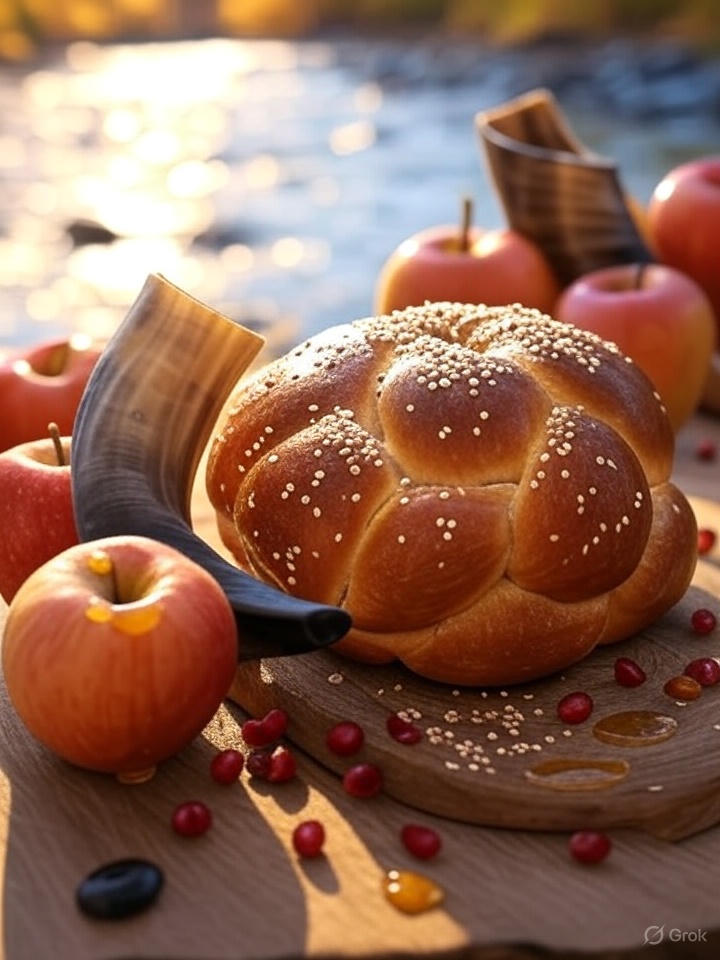Rosh Hashanah, the Jewish New Year, begins at sundown on Monday, September 22, 2025, and ends at sundown on Wednesday, September 24, 2025. This two-day observance marks the start of the Hebrew year 5786, calculated from the traditional date of creation.
Why Jewish Holidays Begin at Sundown
Jewish days begin at evening, following the biblical account in Genesis 1:5: “And there was evening, and there was morning—the first day.” This establishes that each day starts with sunset, reflecting the order of creation.
Names and Calendar Context
Rosh Hashanah has no single biblical name like other holidays; it is called Yom Teruah (Day of Blowing or Shouting) in Hebrew, from Leviticus 23:24, referring to the sounding of the shofar (ram’s horn).
The name Rosh Hashanah means “Head of the Year.” It falls on the first day of Tishri, the seventh month of the Hebrew calendar. This seems counterintuitive for a “New Year,” but the Hebrew calendar has two systems:
- The sacred calendar begins in Nisan (first month), tied to religious events like Passover on the 14th of Nisan, commemorating the Exodus from Egypt.
- The civil calendar begins in Tishri, used for historical and royal reckonings, such as dating kings’ reigns (e.g., 2 Chronicles 34:8 references the 18th year of King Josiah).
In a similar way, Christians date history from the birth of King Jesus (B.C./A.D.), while the Jewish calendar counts from creation.
The Lunar Calendar and Two-Day Observance
The Hebrew calendar is lunisolar, with months starting at the new moon. In ancient times, witnesses in Jerusalem would confirm the sighting and signal distant communities with fires. However, Samaritans sometimes lit false fires, leading to confusion. To ensure accuracy, holidays like Rosh Hashanah are observed for two days in the diaspora.
The new moon was typically announced with silver trumpets, but on Yom Teruah, the shofar—a ram’s horn—is blown instead. It symbolizes the ram God provided as a substitute for Isaac in Genesis 22, representing divine provision and redemption.
Prophetic Significance for Christians
The fall feasts of the seventh month (Rosh Hashanah, Yom Kippur, and Sukkot) foreshadow Christ’s second coming, just as the spring feasts (Passover, Firstfruits, and Shavuot/Pentecost) point to His first coming, death, resurrection, ascension, and the sending of the Holy Spirit.
Rosh Hashanah, as the Feast of Trumpets, connects to the “last trumpet” in 1 Thessalonians 4:16–18 (NIV): “For the Lord himself will come down from heaven, with a loud command, with the voice of the archangel and with the trumpet call of God, and the dead in Christ will rise first. After that, we who are still alive and are left will be caught up together with them in the clouds to meet the Lord in the air. And so we will be with the Lord forever. Therefore encourage one another with these words.”
The Shofar and Its Blasts
The shofar is blown daily during Elul (the month before Tishri) and on Rosh Hashanah in synagogues, as well as at the end of Yom Kippur. It serves as a call to repentance and awakening.
There are four main blast types, sounded in combinations during services, ending with a prolonged tekiah gedolah:
| Blast Type | Pronunciation | Description | Symbolic Meaning |
|---|---|---|---|
| Tekiah | tuh-KEE-ah | One long, unbroken note | A summons or king’s coronation; reaffirms God’s sovereignty. |
| Shevarim | shih-vah-REEM | Three medium wails | Sounds of brokenness or weeping; evokes contrition. |
| Teruah | tih-ROO-ah | Nine (or more) short, staccato bursts | An alarm to awaken from spiritual sleep. |
| Tekiah Gedolah | tuh-KEE-ah geh-doh-LAH | Extra-long tekiah | A triumphant, concluding call. |
Biblical Uses of Trumpets
In Scripture, trumpets (shofars or silver) signaled various events, blown by priests or leaders (Numbers 10). Here’s a summary:
| Purpose | Biblical Reference/Example |
|---|---|
| 1. Breaking camp (during wilderness journey) | Numbers 10:5–6 |
| 2. Calling an assembly | Numbers 10:3 |
| 3. Marking feast-day sacrifices | Numbers 10:10 |
| 4. Warning of war or danger | Numbers 10:9; Joel 2:1 |
| 5. Praise and worship | 2 Chronicles 5:12–13 |
| 6. Announcing processions or feasts | Psalm 68:24–25 |
| 7. Proclaiming a king | 1 Kings 1:34 |
| 8. Assembling troops | Judges 7:16–18 (Gideon) |
| 9. Sounding in battle | Joshua 6:20 (Jericho) |
| 10. Declaring victory | Exodus 15:20–21 (after Red Sea) |
Trumpets also carry deeper spiritual meanings:
- God’s power to raise the dead (1 Corinthians 15:52; 1 Thessalonians 4:16).
- Proclaiming the gospel (Psalm 98:6, often rendered as 89:15 in some translations).
- Prophets’ bold preaching (Isaiah 58:1; Hosea 8:1; Joel 2:1).
- End-times judgments (Revelation 8:2, 13).
Additional Traditions
- Apples and Honey: Eaten to symbolize a sweet new year.
- Round Challah: This braided bread is baked round to represent the cycle of life and seasons, sweetened for hopes of a blessed year.
- Tashlich: On the afternoon of the first day, people go to flowing water (e.g., a river) and cast in crumbs or stones, symbolizing the casting off of sins—echoing forgiveness through Jesus.
Rosh Hashanah kicks off the Ten Days of Awe (or Yamim Nora’im), a time of introspection and repentance leading to Yom Kippur. The third day after Rosh Hashanah includes the Fast of Gedaliah, a minor fast commemorating the assassination of Gedaliah ben Ahikam, the governor appointed after the First Temple’s destruction in 586 BCE (2 Kings 25:22–26). This fast underscores themes of leadership and communal loss.
© 2025 B Arnold Stein
